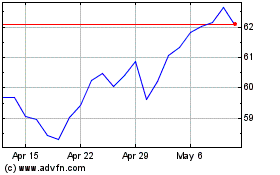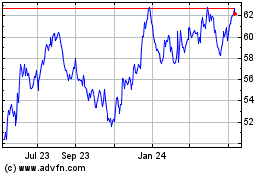Three Micro Cap ETFs To Play The January Effect - Best Performing ETFs
January 03 2012 - 6:01AM
Zacks
With 2011 turning out to be a mixed year to say the least for
the markets, many investors are eagerly looking forward to the new
year and (hopefully) better returns in the equity world. Luckily
for investors, January is usually a pretty strong month for stocks,
suggesting that many could see large gains to start the year if
historical trends hold true once again. This is largely due to what
is popularly known as the ‘January Effect’.
This idea states that stock prices generally have a rough or
so-so December and then surge higher in January thanks to investors
redeploying their capital. This phenomenon could be due to several
reasons, many of which are based on how investors behave around the
end of the year. Primarily, tax-loss selling in December can often
push down stock prices in the month as investors sell some of their
losers in order to harvest losses come tax time. These investors
then wait until the new year to put the money to work in the
market, boosting prices in turn. This effect can be especially
potent for small cap stocks as this asset class has a history of
starting off the year on a high note (read ETFs vs. Mutual
Funds).
However, thanks to widespread knowledge of the phenomenon, the
impact of this has been muted in recent years while the shift to
long-term retirement plans—which have no need for end of year tax
selling—has also reduced the effect across the market. Fortunately,
the effect still can live on in some corners of the market and
especially so in the smallest of the small, the micro cap ETF world
(read Three Outperforming Active ETFs).
These securities have proven to exceed their large cap brethren
primarily in January and not so much in the rest of the year. In
fact, recent research suggests that bottom decile of stocks by
market cap have outperformed the largest tenth by 700 basis points
in January but have matched the return of the space in the rest of
the year. This suggests that January is truly the time to get in on
micro cap securities, assuming that these historical figures hold
true this year as well. Should this be the case, investors should
take a closer look at some of the micro cap ETFs on the market
which could offer up excellent exposure to this potentially potent
stock market anomaly:
iShares Russell Micro Cap Index Fund (IWC)
This ETF tracks the Russell Microcap Index which is a benchmark
that consists of ultra small companies based in the U.S. The
average market capitalization of the fund is just under a quarter
billion while just 4% of assets are classified as small caps as
opposed to micro cap securities. The fund currently consists of
close to 1,400 securities and it puts just 3.3% of assets to the
top ten holdings. Financials take the top spot from a sector
perspective at close to 27.2% while health care (17.4%) and
technology (13.7%) round out the top three. The fund lost 10.4%
last year but has rebounded strongly over the past three months
gaining 14.1% in the period (read Three Low Beta Sector ETFs).
First Trust Dow Jones Select Micro Cap Index Fund (FDM)
This fund from Illinois-based First Trust tracks the Dow Jones
Select Microcap index which follows firms that are in the bottom
two deciles of NYSE stocks. The managers also look to take a more
‘active’ approach in their security selection process, picking
firms based on market capitalization, trading volume, and financial
indicators that include trailing price/earnings ratio, trailing
price/sales ratio, per-share profit change for the previous
quarter, operating profit margin and six-month total return. As a
result, the fund has far fewer securities than its counterparts on
the list with just 239 firms in total (see Avoid Turmoil With The
Community Bank ETF).
Nevertheless, the fund still has a heavy concentration in
financials (24.1%) while industrials (20.5%) and technology (14.7%)
firms round out the top three sectors. However, FDM does have a
heavier concentration in its top ten holdings putting 7.8% of the
total assets in this group and it does have a high turnover level
with the rate coming in at 86% on a yearly basis. Thanks in part to
this, the fund has lost less than IWC in 2011, falling by 8.9% over
the course of the year. Yet, the product also has surged higher in
the past three months as well, gaining 17.7% over that smaller time
period.
Wilshire Micro Cap ETF (WMCR)
The last entrant on the list comes from Guggenheim and its WMCR
which tracks the Wilshire Micro Cap Index. With this benchmark, the
fund tracks close to 830 securities and has the lowest expense
ratio of the group coming in at 50 basis points a year. The fund
puts 7.2% of its assets in the top ten holdings and has just 1.6%
of the assets outside of the micro cap space. This fund also has a
heavy concentration in financials (23.7%), although health care and
tech combine to make up another 35% of the portfolio as well. In
terms of performance, the fund has underperformed despite its lower
cost; losing 20.4% on the year and gaining just 4.7% in the past
three month period (see Three Worst Performing ETFs of 2011).
Want the latest recommendations from Zacks Investment Research?
Today, you can download 7 Best Stocks for the Next 30
Days. Click to get this free report >>
To read this article on Zacks.com click here.
Zacks Investment Research
Want the latest recommendations from Zacks Investment Research?
Today, you can download 7 Best Stocks for the Next 30 Days. Click
to get this free report
First Trust Dow Jones Se... (AMEX:FDM)
Historical Stock Chart
From Jan 2025 to Feb 2025

First Trust Dow Jones Se... (AMEX:FDM)
Historical Stock Chart
From Feb 2024 to Feb 2025
